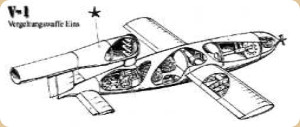Updated: 26-Nov-2022
It is undoubtedly the place in Germany where Schmidt, better known as Schmidt-Rohr, was located.
-Argus would be in charge of the conceived motors' construction and hence the complete name that was sometimes used: Argus-Schmidt-Rohr.
-These engines were pulse jets and several models were made (see Argus) until the most optimal was achieved. This was the one that was installed on the famous Fi-103 or V-1 flying bombs.
-The resulting engine was the Argus 109-014, the better-known final name and which, installed on the flying bomb, had the appearance that we show below. The one marked with a star is the pulsejet engine itself.

“Fi-103 with Argus-Schmidt-Rohr engine”
-As a curiosity, we see a small propeller on the bow of this cruise missile.
-This propeller had an extremely long pitch, it rotated relatively slowly.
-It acted as a counter in such a way that at after an amount of counted revolutions, a device stopped the engine, coinciding more or less with the distance traveled to the target.

"Exploded view of head and valves"
-V1 material gathered together after WWII in which we see two Argus-Schmidt-Rohr 109-014 engines.

“Some V-1 material ”
Engines of ROHR
Model: Argus 109-014
Arquitecture:
Chambers:
Fuels:
Feed System:
Ignition:
Thrust:
Weight:


